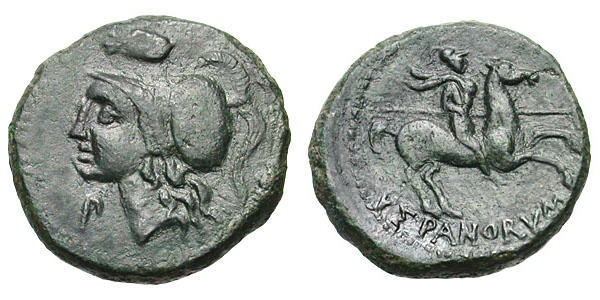Morgantina (the Hispani), bronze (Minerva/horseman) (208-205 BCE)
From SILVER
208 BCE - 205 BCE Bronze
Description
| ObverseInscription or printing placed on the obverse.: | Helmeted head of Minerva facing left. Above, ram's head left. In lower left field, P. |
| ReverseInscription or printing placed on the reverse.: | HISPANORVM (Latin).Horseman in full armor galloping to right, holding spear. Dotted border |
Mint and issuing power
| MintIdentifies the place of manufacture or issue of a numismatic object.: | Morgantina | Ancient regionAncient region.: | Sicily | Modern countryModern country: Italy | AuthorityIdentifies the issuing power. The authority can be "pretended" when the name or the portrait of X is on the coin but he/she was not the issuing power. It can also be "uncertain" when there is no mention of X on the coin but he/she was the issuing power according to the historical sources: | Hispani, Roman Republic |
Chronology
| FromIdentifies the initial date in a range assigned in a numismatic context. | 208 BCE | toIdentifies the final date in a range assigned in a numismatic context.. | 205 BCE | PeriodTime period of the numismatic object.: Hellenistic 323-30 BC |
Physical description
| MetalThe physical material (usually metal) from which an object is made.: | Bronze |
Median weightMedian of the weights of numismatic objects (in grams). in grams | 6.20 | DenominationTerm indicating the value of a numismatic object. Examples: tetradrachm, chalkous, denarius.: | StandardStandard.: |
Image

H 36 - Morgantina, bronze, NC, 150-90 BC.jpg [1]
References
| Die study referencePublication of the study: | Buttrey 19891Buttrey 1989, Group V (12) | ||
| Coin series referenceReference to coin series study: | RQEMH2RQEMH, n° 36, HGC 23HGC 2, n° 914 | ||
| Coin series web referenceCoin series web references: | |||
Obverse dies distribution
| FrequencyFrequency of specimen in distribution. ᵖ | Number of obversesNumber of obverse dies. ᵖ (o) | % (o) | Number of coinsNumber of coins. (n) | % (n) | Die nameName(s) of the die(s). |
| 1 | 4 | 25 | 4 | 5.63 | 5, 6, 10, 13 |
| 2 | 4 | 25 | 8 | 11.27 | 1, 2, 3, 8 |
| 3 | 1 | 6.25 | 3 | 4.23 | 12 |
| 4 | 1 | 6.25 | 4 | 5.63 | 9 |
| 5 | 1 | 6.25 | 5 | 7.04 | 16 |
| 6 | 1 | 6.25 | 6 | 8.45 | 15 |
| 7 | 2 | 12.5 | 14 | 19.72 | 11, 14 |
| 9 | 1 | 6.25 | 9 | 12.68 | 4 |
| 18 | 1 | 6.25 | 18 | 25.35 | 7 |
| Total | 16 of 16 | 100 | 71 of 71 | 100 |
Reverse dies distribution
no distribution is available
Quantification
| Number of obversesNumber of obverse dies. ᵖ (o) | 16 | Number of singletons (o1)The number of singleton coins. ᵖ | 4 |
| Number of reverse diesNumber of reverse dies. (r) | 22 | Number of coinsNumber of coins. (n) | 71 |
| Coins per obverse dieNumber of coins per obverse die. (n/o) | 4.44 | Coins per reverse dieNumber of coins per reverse die. (n/r) | 3.23 |
| Reverse per obverse ratioRatio of obverse dies divided by reverse dies. (r/o) | 1.38 | Percentage of singletons (o1)number of coins (n) divided by the number of singletons (o1) ᵖ | 25 % |
| Original number of dies (O) (Carter 1983 formula)The estimation of the number of coins according to Carter 1983 ᵖ | 18.2 | Coins struck if 20,000 as average productivity per dieCoins made if the average productivity for obverses (according to Carter) is 20,000. ᵖ | 364,000 |
| Original number of dies (O) (Esty 2011 formula)The estimation of the number of coins according to the singleton formula in Esty 2011 ᵖ (O) | 20.65 | Survival rate if 20,000 as average productivity per dieSurvival rate if average productivity is 20,000. ᵖ | 0.00020 |
| Coverage (o = % of O) (Esty 1984 formula)Esty 1984 - coverage (% of O) ᵖ (o = % of O) | 94.37% | Die productivity if survival rate 1/2,000Average productivity if survival rate is 1/2,000. ᵖ | 7,802.2 |
| Weight of silver (in kg) if 20,000 coins per die (O = Carter formula)Carter 1983 * Median weight * 20000 (*10 if gold or electrum) ᵖ | n.a. | Die productivity if survival rate 1/5,000Average productivity if survival rate is 1/5,000. ᵖ | 19,505.49 |
Remarks
Most likely one single workstation